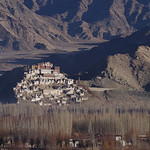35mm full-frame CMOS image sensor
The K-1 incorporates a newly developed 35mm full-frame CMOS image sensor, one that assures the highest image quality to be found in the K-mount SLR series. Thanks to its large imaging area and wide pixel pitch, this high-pixel sensor delivers lively, true-to-life images with rich gradation and minimal noise. Its shallow depth of field allows you to control the sense of depth and bokeh (defocused) effect at will.
Crop mode
Automatic switching of an image area with attachment of a lens
When a DA★-, DA Limited- or DA-series lens is mounted on the K-1, its Crop mode automatically switches an image area to the APS-C size covering the middle section of the image field, while displaying the cropping frame in the viewfinder. It not only assures high-resolution images with approximately 15.36 effective megapixels, but also provides an efficient AF sensor coverage of the image area for more flexible image composition during autofocus operation. When you select the FF (Full Frame) setting of the Crop mode, you can even capture a 35mm full-frame image with a DA-series lens.*With certain lenses and/or under certain photographic conditions, a captured image may suffer a drastic drop in brightness and/or resolution in the areas outside the APS-C image area. This setting does not provide compensation of various lens aberrations.
PRIME IV
The K-1 features a newly designed PRIME IV imaging engine. Compared with the previous PRIME III version, it is fine-tuned to process higher-resolution images, while boosting the operating frequency by nearly 50 percent. Its noise-processing algorithm has also been upgraded to capture beautiful, fine-gradation images at higher sensitivities. A combination of an advanced scene analysis system and new image-processing functions helps improve the accuracy and reliability of image reproduction.
ISO 204800
By taking full advantage of the image sensor excelled in noise-resistance performance and the PRIME IV imaging engine, the K-1 provides a top sensitivity of ISO 204800 (at standard output sensitivity). This not only delivers high-resolution images free of tone jumps and graininess at high-sensitivity settings, but also improves image quality in the low-sensitivity range. Since the K-1 allows you to raise the sensitivity level to capture images equal in image quality to those taken at lower sensitivities, it expands the boundaries of photographic expression.
Pixel Shift Resolution System
Reinforced with the SR (Shake Reduction) mechanism, the K-1’s Pixel Shift Resolution System* captures four images of the same scene by shifting the image sensor by a single pixel for each image, then synthesizes them into a single, super-high-resolution composite image. Compared to the conventional Bayer system, this innovative system obtains all RGB color data in each pixel to deliver beautiful images with far more truthful colors and much finer details, without any hint of false color. This system also reduces high-sensitivity noise to a minimum. The difference in image quality is evident at a glance, even without magnifying the captured image on a computer screen or producing a large-size print. Images captured by the Pixel Shift Resolution System can be saved as RAW-format files. You can developed these files within the camera body while adjusting various parameters or turning the Pixel Shift Resolution effect on and off to create a new image.
Digital level
Accurate detection of camera tilt without removing the eye from the subject
The K-1’s Digital Level displays bar scales at the right side and bottom of the viewfinder to indicate the horizontal and vertical tilt of the camera, allowing you to confirm the horizontal and vertical alignment of the subject without taking the eye off the subject. You can also display the Digital Level on the LCD monitor during viewfinder shooting, Live View shooting and movie recording.
Diffraction Correction
This function compensates for the drop in resolving power caused by the diffraction during image processing. Based on obtained image data, it provides an exposure compensation of up to approximately two aperture steps,* making it useful for such subjects as landscapes, which requires you to close down the aperture to widen a depth of field without compromising the resolving power.
Extra-durable shutter unit
Withstanding 300,000 shutter releases for professional use
After a series of exacting performance tests, the K-1’s shutter unit has proven its exceptional durability by withstanding a total of 300,000 shutter releases. It assures outstanding operational precision and exceptional durability required for exacting professional work.
Dual card slot
Large-volume image data filing on two SD memory cards
The K-1’s card slot accepts two SD memory cards, with a choice of three data filing modes: “Serial” to store a large volume of data successively from one card to another; “Duplicate” (simultaneous filing) for simplified data backup, and “RAW/JPEG Division” to separate data files based on the recording format. It is also possible to copy an image stored on one card to another.
-10°C cold-resistant construction
Unmatched reliability proven under vigorous testing conditionsAnticipating use in cold locations, PENTAX has subjected the K-1 to exacting environmental tests at temperatures as low as –10°C, and gathered a vast array of data on operational precision, response and stability of mechanisms and circuits, as well as fluctuations in battery voltage.* As the result, the K-1 assures solid, trouble-free operation even at freezing temperatures.
Battery performance declines as the temperature goes down. When shooting in cold environments, the user is advised to carry spare batteries and keep them warm by storing them in an inside pocket.
DRII (Dust Removal II) mechanism
Effective removal of foreign particles from the image sensorUsing its piezoelectric element, this innovative mechanism applies ultrasonic vibrations to the optical glass panel placed in front of the image sensor. This effectively removes all dust particles clinging to the image sensor surface, and prevents annoying dust spots from appearing on a captured image.
High-rigidity, extra-durable body
A shell structure shielding a metallic chassis with a magnesium alloy casingThe K-1’s exterior casing is made of highly rigid, lightweight magnesium alloy, which provides excellent shock-resistance and electromagnetic shielding performance. By coupling it with a high-rigidity metallic chassis housing the core components, the K-1 forms a compound structure to assure outstanding durability and exceptional reliability.






















